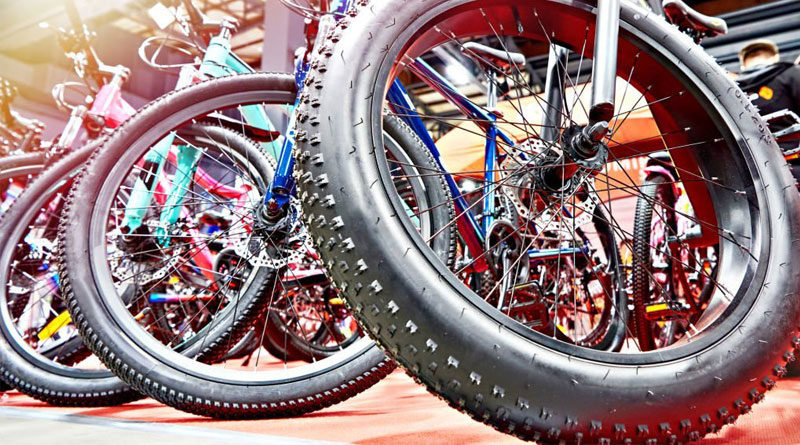Wide Tires vs. Narrow Tires: A Comparison
Lately, there has been a lot of fuss around tire width. For a long time, it was believed that narrow tires roll faster. They have less weight and less contact area making them faster to accelerate. But then came the discovery of wide tires being faster which was completely contrary to theoretical beliefs. Among tires with a width of 23, 25, and 28mm, the 23mm tires performed the worse. No difference in performance was found from 25mm up to 54mm. Not only were they faster, but they were also more comfortable. Professionals were the first to make the change. Now we don’t see them using a 21mm tire. Most of them use 24 or 25mm tires. But why…?
The following is a comparison between wide and narrow tires and why wider tires are better.
Rolling Resistance
Rolling Resistance is caused by the opposing frictional forces that make the tire difficult to roll. A biker with limited physical power wants the utmost efficiency. To achieve that efficiency, the tire should roll as easily as possible. The main reason for energy loss is deformation in the structure of the tire caused by opposing frictional forces.
At approximately 12.5 mph, air resistance becomes the main resistance force. Air resistance rises exponentially with increased speed. Then there is friction from the surface as well which, although, is necessary to push you forward but also causes energy losses. If you are riding uphill, the tires would also have to overcome gradient resistance (grade resistance). The friction in the chain and other rotating parts of the bike plays a minor role in the total resistance.
Factors like tire pressure, diameter, construction, and tread, all affect the rolling resistance along with other factors. The effect of inflation pressure is the opposite on smooth and uneven surfaces. On smooth surfaces, high inflation pressure causes less rolling resistance. The tire remains firm causing less deformation. On uneven ground, low inflation pressure allows the tire to adapt better to the surface. The tire doesn’t sink in reducing rolling resistance.
The elasticity of the tire also influences the rolling resistance produced by the tire. It is important to note here that elasticity is not how much the tire can stretch. In technical terms, elasticity is the ability of a material to come back to its original shape after it has been stretched. The more elastic the tire, the less rolling resistance it produces.
Theoretically, less material used in the construction of the tire means less material that can deform. But then, no material would mean no rolling resistance. In practice, however, we all know how that would go. Smooth treads also cause less rolling resistance than blocked treads. But less rolling resistance also means less grip which is why we see blocked treads on off-road tires where more grip is required over loose surfaces.
All tires flatten under load. A tire with a smaller diameter causes more rolling resistance because the deformation is proportionally more. The tire would deform more and become less round. Roundness is an important factor between wide and narrow tires.
Wide and narrow tires have the same contact area when they are inflated equally. But under load, wide tires are flattened over width while narrow tires are flattened over the length which means an increased contact area. With more contact area, there is more deformation in the tire when rolling which increases the rolling resistance. With the same inflation pressure, wider tire rolls with more ease. The grip is also improved in a wide tire because the width of the tire increases under load.
Comfort
Narrow tires are used with high inflation pressure which makes them uncomfortable to ride. There are more vibrations when riding with narrow tires. These vibrations cause energy losses. Since the vibrations are coming up the wheels, they cancel some of the energy going down the wheels through the suspension. The rider’s body also absorbs these vibrations causing fatigue.
A wider tire decreases suspension losses. But not all wide tires are fast. A stiff and heavy touring tire is going to be slow no matter how wide. For a wide tire to be fast, it has to have a high-quality casing. A supple casing absorbs less energy coming from the rider and also reduces vibrations which, consequently, reduces suspension losses. Also, the rider isn’t absorbing energy so the body stays relaxed and less fatigued. After all, remaining fresh towards the end also makes you faster.
However, narrow tires have a certain effect that many riders like and is difficult to get rid of. The vibrations from a narrow tire give a more connected feeling. Riders on narrow tires feel they are going faster even when they are actually slower. A wider tire is more comfortable and doesn’t give such a connected feel. Riders don’t feel fast on wider tires because there is less rattling in the frame. Many riders ride a 24mm tire instead of a 25mm tire because of this placebo effect.
Acceleration
It is believed that narrow tires have less weight so it should be easier to accelerate them. While wider tires are heavier, air doesn’t add weight to the tire. It is the casing and the rubber that add weight to the tire. But this addition doesn’t affect the acceleration. That’s because bikes don’t accelerate quickly enough to make a difference. Even professionals are too slow to be influenced by the weight of the tire. A car or a motorcycle accelerates fast enough to be affected by the tire weight. But even the toughest human doesn’t have that much power output.
That is why professionals don’t use the smallest diameter of the wheel allowed by the UCI which is 55cm. Of course, the smallest diameter wheel would be the lightest as there is less material used in the construction. But professional riders usually use 700C wheels that are 65cm; 10cm larger than the smallest wheel size allowed. Another reason for not using the smallest diameter wheels is mentioned above. A smaller diameter means more deformation proportionally.
Aerodynamics
Bike tire manufacturer René Herse Cycles claims that tire widths from 25mm up to 54mm perform the same. There is no performance difference even on smooth surfaces. German magazine Tour, in experiments, found that a 28mm tire has the same air resistance as a 25mm tire when the wind is coming from straight ahead. In crosswinds, the 28mm tire was slightly less aerodynamic than the 25mm. But the difference was so negligible that the reduced suspension losses make up for that.
Final Thoughts
Contrary to old popular belief, you can use a tire as wide as you like. The width won’t affect your performance up to a certain limit. In fact, to some extent, increasing the width of the tire will help you to make gains in performance. Wide tires are comfortable and provide a better cornering grip. But not all wide tires are fast. If you want a wide tire to be fast make sure it has a high-quality casing. The casing quality is important for the performance of the tire as it reduces energy losses. But high-quality casings are expensive and only found in premium high-performance tires. Narrow tires are great if you want more feel of the road. The vibrations with a narrow tire make riders feel faster. But there is more rolling resistance which makes narrow tires slow even on smooth surfaces.




